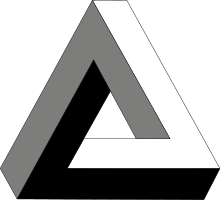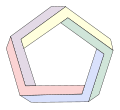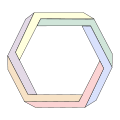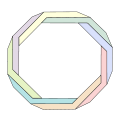Penrose triangle

The Penrose triangle, also known as the Penrose tribar, or the impossible tribar,[1] is an impossible object. It was first created by the Swedish artist Oscar Reutersvärd in 1934. The psychiatrist Lionel Penrose and his mathematician son Roger Penrose independently devised and popularised it in the 1950s, describing it as "impossibility in its purest form". It is featured prominently in the works of artist M. C. Escher, whose earlier depictions of impossible objects partly inspired it.
Impossible object
The tribar appears to be a solid object, made of three straight beams of square cross-section which meet pairwise at right angles at the vertices of the triangle they form. The beams may be broken, forming cubes or cuboids.

This combination of properties cannot be realized by any 3-dimensional object in ordinary Euclidean space. Such an object can exist in certain Euclidean 3-manifolds.[2] There also exist 3-dimensional solid shapes each of which, when viewed from a certain angle, appears the same as the 2-dimensional depiction of the Penrose triangle on this page (such as - for example - the adjacent image depicting a sculpture in Perth, Australia). The term "Penrose triangle" can refer to the 2-dimensional depiction or the impossible object itself.
M.C. Escher's lithograph Waterfall (1961) depicts a watercourse that flows in a zigzag along the long sides of two elongated Penrose triangles, so that it ends up two stories higher than it began. The resulting waterfall, forming the short sides of both triangles, drives a water wheel. Escher helpfully points out that in order to keep the wheel turning some water must occasionally be added to compensate for evaporation.

If a line is traced around the Penrose triangle, a 3-loop Möbius strip is formed.
Although the tribar is named one of the impossible objects, there exist many more that fit into the same category. Other impossible objects include the devil's fork, the dancing elephant, and impossible arch.[3]
Other Penrose polygons
While it is possible to construct analogies to the Penrose triangle with other regular polygons to create a Penrose polygon, the visual effect is not as striking, and as the sides increase, the object seems merely to be warped or twisted.
See also
References
- ↑ Pappas, T. "The Impossible Tribar." The Joy of Mathematics. San Carlos, CA: Wide World Publ./Tetra, p. 13, 1989.
- ↑ Francis, George (1988). A topological picturebook. Springer. ISBN 0-387-96426-6. In the chapter on the Penrose tribar, Francis attributes this observation to John Stillwell.
- ↑ Adamovic, Jan. "BrainDen.com - Impossible Objects". BrainDen.com. Retrieved 2016-02-09.
External links
| Wikimedia Commons has media related to Penrose triangle. |



